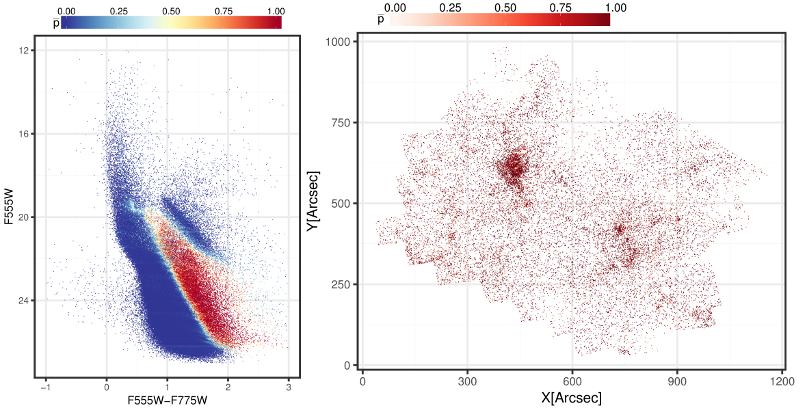| EPoS Contribution |
|
Deciphering Clustered Star Formation with Machine Learning Techniques
Dimitrios Gouliermis MPIA/U Heidelberg, Heidelberg, DE | |
| Low-mass pre--main-sequence (PMS) stars preserve the complete record of star formation of their natal giant star-forming regions in both space and time. Their spatial locations indicate the signposts, where clustered star formation occurs across the region, and they usually coincide with the centers of massive star formation. In addition, their CMD-positions make them perfect chronometers of the recent star formation history in the region due to their long evolution towards the main-sequence. We can thus use low-mass PMS stars to map star formation in space and time across a whole star-forming complex. However, identifying these stars and determining their physical parameters from photometry alone is not trivial due to several observational and physical constraints that dislocate the stars from their theoretical CMD-positions. The Hubble Tarantula Treasury Project (HTTP) has provided an unprecedented stellar photometric catalog across the entire region of the starburst of 30 Doradus in the Large Magellanic Cloud. We employ Machine Learning Classification techniques to identify the most probable PMS stars of the HTTP field, using as a training sample the PMS stellar content of the star-forming cluster NGC 2070, where the starburst cluster R136 is located. Our method returns the unique sample of almost 20,000 sources spread across the Tarantula nebula. I will present the results of our clustering analysis of these stars in combination with the young high-mass stellar content of the region in terms of both spatial and age distribution, building the map of star formation in space and time across the most active star-forming complex in the Local Group. | |
 | |
| Caption: Optical CMD of the stars (left), and the spatial distribution of the identified PMS stars (right) across the Tarantula nebula. Stars are color-coded according to the mean predicted PMS membership probability, determined with two Machine Learning classification methods: Support Vector Machines and Random Forests. The PMS map demonstrates the significant sub-structure in the clustering pattern of PMS stars across the nebula. The employment of Machine Learning clustering techniques on this distribution determines the cluster population of the nebula, and quantifies the hierarchical structure of the star-forming complex in terms of space and time. | |
| Collaborators: V.F. Ksoll, U Heidelberg, DE R.S. Klessen, U Heidelberg, DE E.K. Grebel, U Heidelberg, DE E. Sabbi, STScI, US D.J. Lennon, ESA, ES J. Anderson, STScI, US R.P. van der Marel, STScI, US A. Aloisi, STScI, US M.L. Boyer, ORAU, US M. Cignoni, U Pisa, IT G. de Marchi, ESA, NL S.E. de Mink, U Amsterdam, NL C.J. Evans, ROE, UK J.S. Gallagher III, U Wisconsin, US K. Gordon, STScI, US A.M. Koekemoer, STScI, US S.S. Larsen, Radboud U, NL N. Panagia, STScI, US L.J. Smith, ESA/STScI, US M. Tosi, U Bologna, IT D. Zaritsky, Steward Obs., US |
Suggested Session:
High-mass star/star cluster formation |

